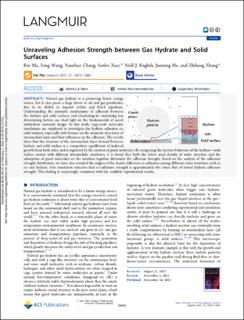| dc.contributor.author | Ma, Rui | |
| dc.contributor.author | Wang, Feng | |
| dc.contributor.author | Chang, Yuanhao | |
| dc.contributor.author | Xiao, Senbo | |
| dc.contributor.author | English, Niall | |
| dc.contributor.author | He, Jianying | |
| dc.contributor.author | Zhang, Zhiliang | |
| dc.date.accessioned | 2022-02-01T09:46:25Z | |
| dc.date.available | 2022-02-01T09:46:25Z | |
| dc.date.created | 2021-11-03T14:00:04Z | |
| dc.date.issued | 2021 | |
| dc.identifier.issn | 0743-7463 | |
| dc.identifier.uri | https://hdl.handle.net/11250/2976193 | |
| dc.description.abstract | Natural gas hydrate is a promising future energy source, but it also poses a huge threat to oil and gas production due to its ability to deposit within and block pipelines. Understanding the atomistic mechanisms of adhesion between the hydrate and solid surfaces and elucidating its underlying key determining factors can shed light on the fundamentals of novel antihydrate materials design. In this study, large-scale molecular simulations are employed to investigate the hydrate adhesion on solid surfaces, especially with focuses on the atomistic structures of intermediate layer and their influences on the adhesion. The results show that the structure of the intermediate layer formed between hydrate and solid surface is a competitive equilibrium of induced growth from both sides, and is regulated by the content of guest molecules. By comparing the fracture behaviors of the hydrate–solid surface system with different intermediate structures, it is found that both the lattice areal density of water structure and the adsorption of guest molecules on the interface together determine the adhesion strength. Based on the analysis of the adhesion strength distribution, we have also revealed the origins of the drastic difference in adhesion among different water structures such as ice and hydrate. Our simulation indicates that ice-adhesion strength is approximately five times that of lowest hydrate adhesion strength. This finding is surprisingly consistent with the available experimental results. | en_US |
| dc.language.iso | eng | en_US |
| dc.publisher | American Chemical Society | en_US |
| dc.rights | Navngivelse 4.0 Internasjonal | * |
| dc.rights.uri | http://creativecommons.org/licenses/by/4.0/deed.no | * |
| dc.title | Unraveling adhesion strength between gas hydrate and solid surfaces | en_US |
| dc.type | Peer reviewed | en_US |
| dc.type | Journal article | en_US |
| dc.description.version | publishedVersion | en_US |
| dc.source.journal | Langmuir | en_US |
| dc.identifier.doi | 10.1021/acs.langmuir.1c02315 | |
| dc.identifier.cristin | 1951038 | |
| dc.relation.project | Norges forskningsråd: 302348 | en_US |
| dc.relation.project | Notur/NorStore: nn9110k | en_US |
| dc.relation.project | Notur/NorStore: nn9391k | en_US |
| cristin.ispublished | false | |
| cristin.fulltext | postprint | |
| cristin.qualitycode | 2 | |

